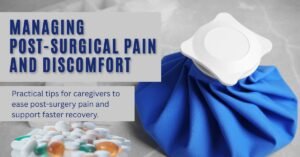Regaining mobility after surgery is a crucial part of the healing process. Movement restores strength, prevents complications, and rebuilds confidence. For caregivers, supporting mobility recovery means striking a balance between safety and encouragement — guiding patients through every careful step toward independence. This post serves as a complete guide for caregivers assisting patients regain mobility after surgery. It explains general principles of mobility recovery and highlights how approaches differ for various surgeries.
Understanding Post-Surgical Mobility Challenges
After surgery, patients often experience stiffness, weakness, pain, or fear of moving. Muscles lose tone from prolonged bed rest, and joints may become stiff and tight. Emotional barriers, such as anxiety about pain or re-injury, also slow progress.
Each patient’s recovery journey is unique. Factors such as age, type of surgery, and overall health influence how quickly somebody can safely resume movement. Consistency, patience, and gentle motivation are the keys to regain mobility after surgery.
Role of the Caregiver in Mobility Recovery
Caregivers play a central role in regaining mobility after surgery. They provide both physical assistance and emotional reassurance, helping patients move safely while maintaining positivity and patience.
Key caregiver responsibilities:
- Follow the physiotherapist’s and doctor’s mobility guidelines.
- Encourage gradual movement and safe practice.
- Observe for signs of strain, dizziness, or swelling.
- Record daily progress and small milestones.
By combining empathy with attentiveness, caregivers help create a safe path to recovery.
Creating a Safe Environment for Movement
A well-prepared home is essential for mobility recovery. Simple safety adjustments reduce risks and make daily movement easier.
Tips for caregivers:
- Keep pathways clear and remove loose rugs or clutter.
- Install grab bars near bathrooms and stairs for added safety and security.
- Ensure good lighting in all areas.
- Use assistive devices such as walkers, canes, or non-slip mats to help you stay stable.
- Encourage supportive, non-slip footwear.
For detailed setup guidance, visit: How to Prepare Home for Patient Care: Step-by-Step Guide for Caregivers
Different Mobility Approaches for Different Surgeries
Not all surgeries require the same rehabilitation approach. The body heals differently depending on which system is affected, such as the musculoskeletal, neurological, cardiac, or abdominal system. Understanding these distinctions helps caregivers provide the right kind of support.
1. After Orthopaedic Surgeries (Knee or Hip Replacement)
- Focus on rebuilding joint strength, flexibility, and balance to improve overall mobility.
- Begin gentle exercises under a physiotherapist’s guidance as soon as possible.
- Use mobility aids like walkers or crutches safely and securely.
- Encourage regular, pain-free movement to avoid stiffness.
2. After Brain or Neurological Surgeries
- Emphasise coordination, balance, and gradual retraining to achieve optimal results.
- Work closely with neurorehabilitation specialists.
- Offer emotional encouragement — recovery may be slow and frustrating.
- Prevent falls and fatigue with constant supervision.
3. After Cardiac Surgeries
- Focus on controlled activity to build endurance without strain.
- Begin with short, slow walks and deep-breathing exercises.
- Monitor for chest pain, dizziness, or shortness of breath.
- Encourage rest breaks and avoid heavy lifting or sudden exertion.
4. After Abdominal Surgeries
- Encourage gentle walking to improve circulation and digestion.
- Avoid pressure on the abdomen — no twisting or heavy lifting.
- Help maintain upright posture and slow breathing exercises.
You can explore each of these specific mobility plans in detail later. For now, caregivers should remember that slow, safe, and supervised movement always leads to the best outcomes.
Gradual Steps to Regain Mobility
A steady and structured approach is most effective.
Caregiver steps:
- Start small: Begin with simple movements, such as changing position or sitting up.
- Progress safely: Move from bed-to-chair transfers to brief assisted walks.
- Track improvements: Keep a mobility diary to note progress, comfort levels, and duration of movement.
- Encourage independence: Gradually allow the patient to perform light movements alone when ready.
For comfortable recovery, also explore pain relief techniques in: Managing Post-Surgical Pain and Discomfort
Motivation and Emotional Support
Physical recovery can be tiring — emotionally and mentally. Caregivers should create an environment of encouragement, where each small success feels rewarding and appreciated.
- Celebrate small milestones.
- Maintain a daily routine to build confidence.
- Listen and reassure when patients feel discouraged.
- Remind them that slow progress is still progress.
A positive mindset can often accelerate and enhance physical healing.
When to Seek Professional Help
Contact a healthcare provider or physiotherapist immediately if the patient experiences:
- Persistent or sharp pain
- Swelling, redness, or warmth at the surgical site
- Dizziness or shortness of breath
- New weakness or loss of coordination
Timely intervention prevents complications and ensures safe recovery.
Conclusion
Helping someone regain mobility after surgery is more than a physical process. It’s also an emotional journey built on trust, patience, and daily care and attention. As a caregiver, your encouragement, vigilance, and compassion can transform recovery into a positive experience.
Remember: Every safe step, no matter how small, brings your loved one closer to independence and confidence once again.
FAQs
It depends on the type of surgery and overall health. Most patients start gentle movement within days, but full recovery can take weeks or months.
Help with safe transfers, encourage doctor-approved exercises, and create a fall-free environment.
No. Orthopaedic, cardiac, abdominal, and neurological surgeries all have different recovery speeds and activity levels.
Use positive reinforcement, track small wins, and celebrate consistent efforts.
Stop movement if the patient feels severe pain, dizziness, swelling, or fatigue. Seek medical advice before continuing.





